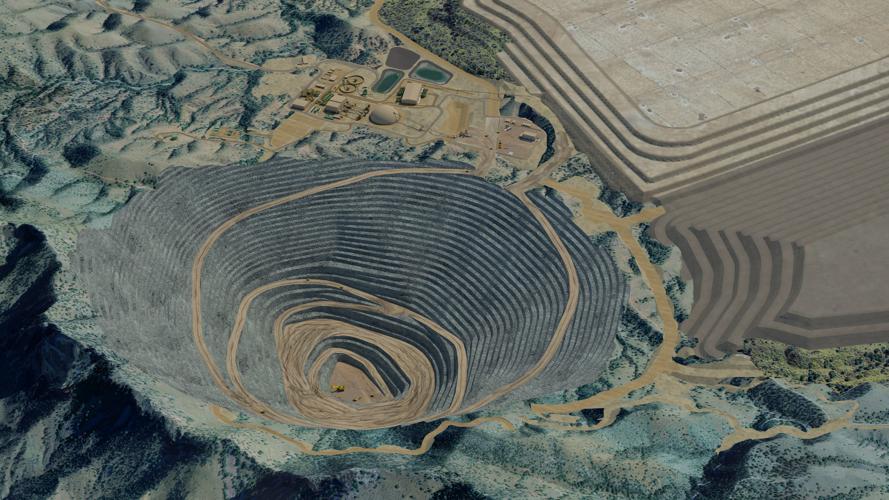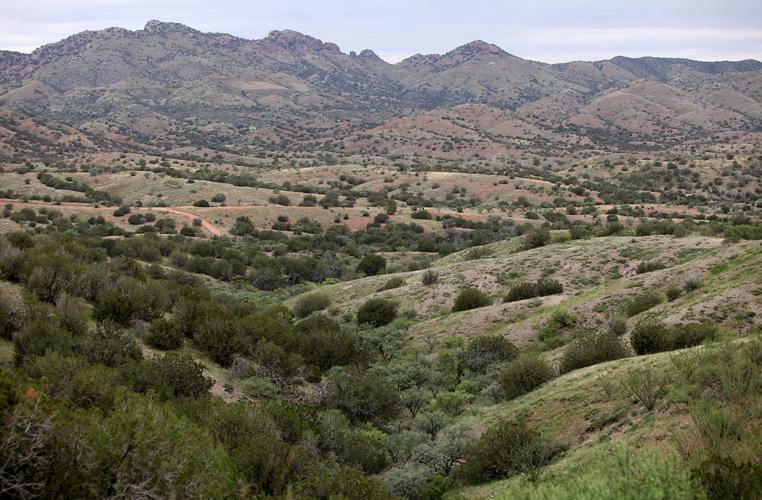A federal judge in Tucson could break new ground this week in deciding:
- Whether the U.S. Forest Service can legally say “no” to the proposed Rosemont Mine.
- How to tell if the mine is likely to illegally destroy critical habitat, in this case for the endangered jaguar.
- How broadly to examine the impacts in permitting a small but important slice of the project — its discharge of fill material into washes atop which the mine would be built.
These and many other issues were argued in detail at a daylong court hearing Tuesday on five lawsuits opponents have filed to halt construction of the $1.8 billion mine in the Santa Rita Mountains southeast of Tucson.
The suits challenge various approvals by the Forest Service, the Fish and Wildlife Service and the Army Corps of Engineers for what would be the U.S.’ third largest copper mine.
U.S. District Judge James Soto said he would rule by Thursday, August 1, on at least some of these suits.
He could rule on efforts by opponents to get injunctions that would block construction until the judge can rule on the suits’ legal merits. Or, in the case of lawsuits against the Forest Service and Fish and Wildlife Service, which were filed two years ago, he may even be ready to rule on the merits.
Here are three key issues before the judge:
Just say “yes.”
That’s been the Forest Service’s attitude toward mining on federal lands — that it lacks legal authority to stop a mine if its owner shows it can meet all federal laws.
To make that case, it’s cited the General Mining Act of 1872, passed to encourage mining on federal lands, and a host of other laws and regulations approved since then.
The mine opposition group Save the Scenic Santa Ritas, and a coalition of the Tohono O’Odham, Pascua Yaqui and Hopi tribes, seek to bust that theory.
Their attorneys point particularly to the lack of known mineral deposits on lands outside the site for the mine’s open pit, from which 5.88 billion pounds of copper are expected to be removed over 20 years.
In particular, they cite Hudbay Minerals’ Inc. plans to place waste rock on 1,460 acres, and dry stack mine tailings on 987 acres, away from the copper resources.
The 1872 law restricts development of mining claims to lands where a “valuable mineral deposit” exists, the mine opponents say.
Various court decisions have backed up that position, as did the 1955 Common Materials Act, which took rock, stone and other non-mineral substances out of the 1872 law’s purview, they told Soto.
“The law specifically prohibited the end use of lands that don’t contain valuable minerals. We think the issue on the mining law is pretty straightforward,” Roger Flynn, attorney for Save the Scenic Santa Ritas, told the judge.
But U.S. government attorney Andrew Smith and Hudbay attorney Norm James said federal mining regulations have for years operated under the principle that activities related to mining are allowed even on forest lands without minerals.
The opponents’ reference to the 1955 act is a “red herring,” said James. That law removed from the 1872 act’s purview the ability to file mining claims on public land containing rock, gravel, stone and pumice.
“That has nothing to do with the issue here,” James said.
Mining regulations dating back to 1974 allow mining activities on forest lands “for legitimate, bona fide purposes, not for a hunting lodge or a curio shop or livery stable — bona fide activities for mining,” James said.
“The way the Forest Service has interpreted that is to say that all uses incidental to mining operations are covered including access roads,” James said.
Smith cited a 1975 criminal case in which the U.S. 9th Circuit Court of Appeals ruled. The court found it was legally okay for someone to remove timber from federal lands — to which he had filed mining claims — to build housing away from the claimed land. This activity was ruled legal under the federal Multiple Use Act, Smith said.
Essentially, the ruling means that uses carried out incidentally to a mining claim “do not have to be within confines of the mining claim,” Smith said. “They can occur on or off that claim.”
Also, the analysis done for the Forest Service’s Rosemont environmental impact statement found that the mine wouldn’t be economically viable if it couldn’t use lands adjoining where it had mining claims, Smith said.
In rebuttal, Heidi McIntosh, an attorney for the tribes, said there’s no obvious limit to Hudbay’s and the Forest Service’s view of how far a mining operation can set up shop away from the actual minerals.
“How far can the mining law go? It seems that under their theory it only goes to where the mining company decides is needed to enhance the economic viability of the mine, and that the Forest Service has no discretion to protect other kinds of resources,” said MacIntosh.
“Forest Service lands are not just available for use by industry when industry wants to use them.”
The 1975 9th Circuit case that Smith cited doesn’t apply to Rosemont, Flynn said, because it involves timber taken directly off a site with valid mining claims to known mineral deposits.
“We’re not arguing they can’t take trees off the pit. We’re arguing, ‘Do you have the right to use that land a half-mile away?’”
Role reversal for a federal whistleblower
Retired Fish and Wildlife Service official Steve Spangle, a recent hero for environmentalists for his role as a whistleblower against a huge Benson development, was a big target for Rosemont opponents in court last week.
Spangle decided in 2013 and reaffirmed that decision in 2016, in separate biological opinions for the wildlife service, that the mine isn’t likely to illegally damage a federal critical habitat for the jaguar.
That was despite the presence of an adult male jaguar near the mine site for three years ending in 2015.
Spangle ran the wildlife service’s Arizona office back then. His decision overruled a draft opinion from a lower-level biologist at the service’s Tucson office. That biologist, Sarah Rinkevich, had warned the mine would illegally damage critical habitat.
Center for Biological Diversity attorney Marc Fink told Soto that Spangle on his own created a higher standard than had been used in the past for proving that this illegal damage was likely to occur.
Under previous Justice Department policy and court rulings, the wildlife service had to show that this sort of damage was “probable,” but Spangle upped the ante to “a high probability,” “very probable” and “highly probable,” Fink said.
“We’re not arguing that he can’t overturn his biologist. We’re arguing . . . that the agency has to come up with new evidence as to why they changed course,” Fink said. “Nobody was arguing that there was new evidence.”
Spangle said he changed the wording after consulting the Merriam-Webster’s dictionary for definitions of “likely” — an explanation that drew derision from the mine opponents’ attorneys.
The “likely” standard is “not just something they can pick up from a dictionary off the shelf,” Fink said.
Smith told the judge that the findings of a draft biological opinion aren’t before the judge, and that the feds’ analysis “has to live or die with the 2016 (final) biological opinion,” the one written by Spangle.
James said, “This is one of those classic cases where you may have internal disagreement within an agency, but ultimately you have to make the decision, and your decision gets reviewed.”
In rebuttal, Fink said that in a 2017 case involving a biological opinion change, the 9th Circuit ruled that an analysis was needed in court to justify why a change occurs from a draft to a final opinion.
Spangle recently sparked a congressional investigation when he told the Star that he had been pressured by Interior Department higher-ups to change his opinion on the need for a detailed biological analysis of the 28,000-home Villages at Vigneto project in Benson.
He said that with Rosemont, he made the decision on his own with no pressure from above.
The narrowing scope of the Corps’ review
On the Army Corps of Engineers’ permit for the mine, which was granted under the federal Clean Water Act, both sides agreed that the biggest issue was how broadly — or narrowly — the Corps reviewed the mine’s impacts.
Mine opponents and the U.S. Environmental Protection Agency wanted the Corps to analyze impacts on groundwater withdrawals, surface water pollution and stormwater runoff.
The Corps’ San Francisco-based South Pacific Division, however, limited its analysis mainly to the impacts of grading, grubbing and clearing of washes so fill material can be discharged into them for the mine’s construction. It overruled the agency’s Los Angeles District, which had used a broader scope of analysis in urging denial.
“If this reversal is allowed to stand, it will drive an enormous loophole into the Clean Water Act. It would be a dangerous precedent,” said Stu Gillespie, another attorney for the tribes.
“In the future, every permit would be for grading, grubbing and clearing of washes, to limit the Corps’ jurisdiction,” Gillespie said.
He dinged the Corps for not analyzing or requiring adequate mitigation for what he and EPA have warned would be degradation of downstream water quality by the mine’s holding back of stormwater.
But Simi Bhat, another Justice Department attorney, said the opponents’ view that the Corps needs to consider impacts of mine operations is undercut by at least two past federal court rulings.
In one, the U.S. Supreme Court ruled in 2004 that even if an agency action is a cause of a future activity — in that case the introduction of Mexican-owned trucks in the U.S. — the agency doesn’t have to consider that activity’s impacts in deciding how broadly to analyze them, Bhat said.
Even if the Corps’ scope included analyzing the mine’s effects, the Arizona Department of Environmental Quality has already found that the mine won’t cause state water quality standards to be exceeded, Bhat said.
James noted that in two cases in which the courts sided with environmentalists on that issue, they dealt with the Corps’ scope of analysis under the National Environmental Policy Act, not the Clean Water Act.
“That’s a different statute. It’s broader and requires consideration of environmental impacts,” James said. “It’s not the same issue as here.”
Tribal attorney Gillespie cited a case in which the U.S. 10th Circuit Court of Appeals ruled in 1983.
The court found that the Corps, in denying a permit to fill a tributary of the South Platte River in Colorado to build a dam, had the obligation to analyze the dam’s secondary effects on endangered whooping crane habitat, 300 miles downstream.
The Rosemont Mine’s open pit, tailings and waste rock all would act like dams, blocking passage of surface water to downstream washes, he argued.
“Gillespie said it’s just like our project. No, it’s not. We don’t have a dam,” James replied.





